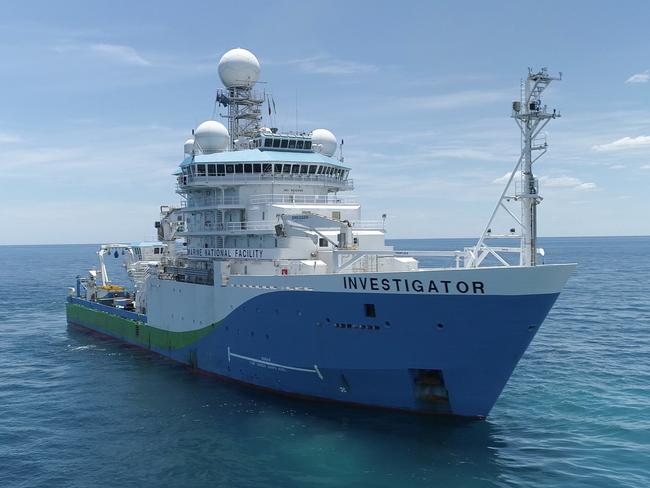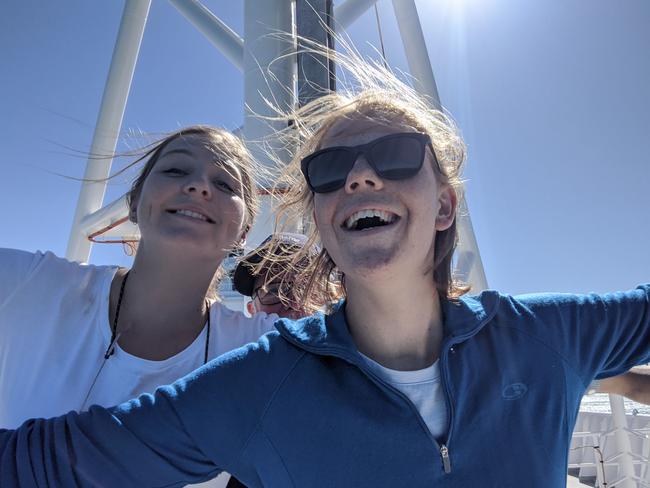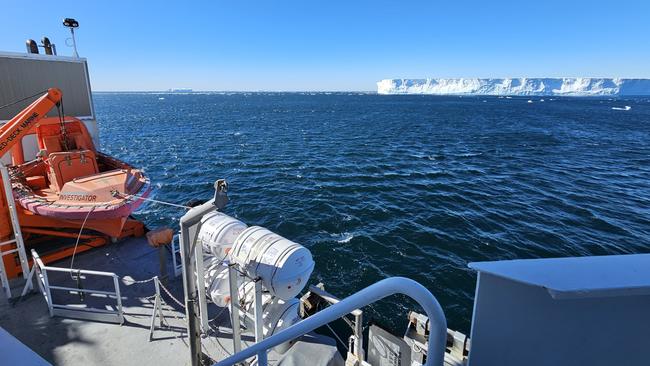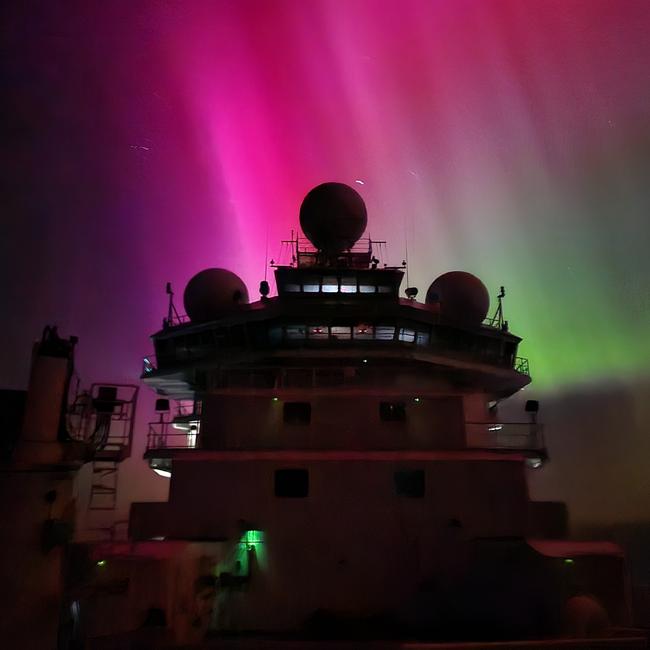When Margot Hind was a child, she was scared of the ocean.
She grew up in regional New South Wales, at least four hours from the nearest beach, so time by the sea was a scarcity.
She certainly never imagined she’d study marine science.
Or that she’d land a job as voyage manager on CSIRO’s national marine ocean research vessel RV Investigator, spending up to two months at a time at sea, leading a team of scientists as they explore the ocean between Australia’s tropical north and the Antarctic ice edge to do groundbreaking biological, oceanographic, geological and atmospheric research.

It’s quite an achievement for the 26-year-old from Battery Point, who has an impressive resume, having participated in eight voyages for a total of 270 days at sea.
She is presently voyage manager on a 60-day journey that began in Hobart on January 5 and is due to finish in Fremantle, Western Australia, on March 5.
The MISO voyage – which stands for Multidisciplinary Investigations of the Southern Ocean – is the longest voyage yet delivered in RV Investigator’s 10-year history and aims to improve scientists’ ability to anticipate the impacts of climate change.

There are 39 scientists across five teams, exploring how links between physics, biogeochemistry, plankton, aerosols, precipitation and clouds influence the earth’s climate, from the deep ocean (up to six kilometres below the water’s surface), to the low-lying clouds two kilometres above sea level in the lower atmosphere.
Scientists know that the Southern Ocean takes in vast amounts of heat and carbon dioxide and acts as a climate “shock absorber”.
So, changes in the Southern Ocean could have profound implications, influencing the rate of climate change, the productivity of the Antarctic ecosystem, and the future of the Antarctic ice sheet.

Data collected on the MISO voyage will be compared with earlier measurements to track how the Southern Ocean is changing and what it means for climate and sea level rise. And Hind’s role on board is to ensure the voyage runs smoothly.
“My role creates a connection between the science party – which can come from many organisations and countries – and the ship’s crew, making sure all is running smoothly and efficiently,’’ Hind says.
And of course there’s plenty to do on land before each voyage begins.
“Typically, we start planning about a year out, with planning really ramping up in the six-month lead-up,’’ Hind says.

“We look at the science objectives and scope of operations, identify what will be required and plan to ensure we can deliver to them.
“This means we do a lot of liaison and engaging with our technical and support teams to get things ready for the voyage.
“We identify where we may need contingency items, assist in integrating new science party equipment as well as create voyage tracks and time estimates.’’
Hind is quick to point out she’s “just one part of a collaborative team”, which includes the ship’s captain – also called the master – and 20 crew, who also help ensure things run smoothly on board the 94m vessel, which can cover 10,000 nautical miles without resupply.

No two days are the same – which is one of the things Hind loves about her job. And even the best laid plans need a rethink if the weather decides not to co-operate.
“It’s really hard to explain what an average day on board looks like … it varies from day to day and voyage to voyage,’’ Hind says.
“A typical day on an oceanographic-focused voyage like the one I am currently on begins with a quick catch up on emails then down to the operations room to check on how the night has gone.
“On a voyage where we’re doing significant operations like deep sea coring or deploying ocean moorings, I start my morning on the bridge with the involved parties to discuss and plan the day’s activities.

“This includes what we call a go/no-go to determine if the conditions are suitable to proceed with a full day of intense operations.
“We consider many things in this discussion including fatigue management, weather conditions, and preparation and sequence of operations.
“I usually spend the day fielding lots of questions from the science party and the crew, and liaising between the two groups … no day is ever the same.’’
Hind says each voyage comes with unique challenges, and weather is the main variable.
“It’s somewhat unpredictable, particularly in the Southern Ocean, and means we must remain flexible,’’ she explains.
“We are constantly watching for deteriorating weather conditions, and this is always in the forefront of our minds. It also means we have to have contingency plans in place that we can enact if the conditions aren’t doing what we need them to.’’

Innovation is often required.
“Another challenge at sea, and particularly in the remote areas of our marine estate that we frequently operate in, is resourcing of spare parts and troubleshooting broken equipment,’’ Hind says.
“It’s not like we can just pop down to the local hardware store to pick up supplies.’’
Voyages on the RV Investigator are unique in that the ship stays at sea for the entire trip. Unlike expeditioners on Hobart-based Antarctic research vessel and icebreaker RSV Nuyina – who typically spend a couple of weeks on board getting to Davis, Casey or Mawson stations and then spend months ashore before making the journey back to Hobart – the RV Investigator scientists spend an extended period doing research at sea.

“Two months is a long time to be at sea, especially when not en route to a destination,” Hind says.
“I think the attitude of a lot of the CSIRO staff on voyages of this length is to just accept the reality of the duration of the voyage.
“It sounds strange but there’s not too much point counting down the days – although inevitably we always do. Getting into a routine is probably the most important part of a long voyage, particularly for those who regularly go to sea.
“It’s important to ensure that you have your daily gym or yoga session in place, or make sure to take time to grab a coffee at morning tea and go outside for fresh air when you can.’’

RV Investigator has plenty of recreation spaces. “We play a lot of table tennis – and the occasional game of Assassin – and ensure we are making time for social activities like science talks and trivia to break up the days,” Hind explains.
“I make sure I pack lots of books and paints, and the occasional face mask – it sounds silly but making sure you can have a little ‘you’ time is important when you’re at sea for 60 days in a row.
“We actually had several days preparation at sea before officially getting under way and departing Hobart.
“Technically, from the time we left our wharf, we will be spending 65 days on the ship before we step back onto dry land.’’

Hind’s previous trips include a 35-day voyage from Darwin to Fremantle in October 2022 to map and survey biodiversity in the Cocos (Keeling) Islands Marine Park – a remote Australian territory in the Indian Ocean midway between Australia and Sri Lanka.
It was her first trip as voyage manager, and she spent her 25th birthday at sea.
Hind was also part of the geoscience voyage off western Tasmania in April 2023 that ended a 50-year mystery and confirmed the location of the MV Blythe Star.
The 44m freighter sank off southwest Tasmania in 1973, leading to the largest maritime search ever conducted in Australia at that time.
The crew of 10 escaped in an inflatable life raft but tragically one died at sea and two more died shortly after they made it to shore at Deep Glen Bay on the Forestier Peninsula, north of Eaglehawk Neck.

Two survivors scaled cliffs and battled thick scrub to get help, with the crew finally rescued 11 days after the boat sank.
No trace of Blythe Star was found until local fishing boats in the mid-1990s identified the presence of a large wreck.
The wreck was formally identified last year, with Hind leading the voyage.
“The Blythe Star project was part of a five-week voyage studying the sea floor off the southwest coast of Tasmania and I think will remain as one of my favourite and most memorable voyages,’’ Hind says.
“Being involved in the wreck survey was an honour and, almost immediately after that was completed, we tracked north along the coastline which offered an incredible view of the West Coast.’’

The wreck was covered with minimal growth of algae and seaweed. Some structures showed signs of damage, particularly the stern. They observed marine life on and around the wreck, including crayfish, schools of fish and fur seals.
Data has since been provided to state and national maritime heritage agencies.
It is hoped the mapping and video footage may help answer questions about what caused the vessel to sink.
Meanwhile, Hind’s Cocos (Keeling) Islands trip was part of a voyage discovering a shark graveyard and collecting over 700 shark teeth in a dredge from the sea floor, including fossilised teeth of an ancient ancestor of the megalodon shark.

“The Cocos (Keeling) voyage was great, partially because it was a tropical voyage,’’ Hind says. “They are a stark difference to Southern Ocean voyages – you don’t have to really consider weather contingency days on tropical voyages and that’s a plus! It was a spectacular voyage, mapping so much unmapped ocean floor.
“It’s amazing how little we know about our oceans, to the point where we’re creating the first maps of deep seamounts that rise over 4000m from the sea floor to then be just 20m below the surface.
“It certainly felt like we were uncovering deep ocean life, with many new discoveries along the way. The sea life on the surface of the ocean and above was also spectacular with tropical birds, sharks, turtles, mahi mahi (dolphinfish) and mola mola (ocean sunfish) all spotted from the ship.”
It’s not a bad effort for a kid that feared the ocean.

“I grew up in Albury, in New South Wales – a fair way from the ocean,’’ Hind explains.
“I was actually really scared of the ocean when I was a kid … I grew up on a large lake, so I was much more comfortable with the murky brown waters and the occasional nibble on the toes from a yabby.
“I chose science-based units at high school and loved geography and earth and environmental science, and eventually wanted to study climate science. During those years we holidayed in Lorne, Victoria and the NSW central coast a lot, so, lots of poking through rock pools and whale watching.’’
In her gap year, she decided Hobart was “a pretty good place to live” and enrolled in a bachelor of marine and Antarctic science.

“I had a particular interest in high seas fisheries, and the interactions between policy and science so chose to study the governance stream of the degree,’’ Hind says.
“I don’t think I ever thought I’d be a scientist, but I knew I wanted to be able to understand the significant gap between science and policy in a time where we need to bridge that gap urgently.’’
She first joined RV Investigator as a student on a research voyage. But never imagined she’d soon be leading those voyages.
“I hesitate to use the words I’m about to say for fear of it being cliche, but my first trip as a science student on RV Investigator was pretty life-changing,’’ she says.
“I didn’t think I’d have too much of an opportunity to join a research voyage but, luckily, the chief scientist on the voyage was really interested in getting policy students involved in the science to show how it can contribute to the United Nations Law of the Sea.

“I headed out on an eight-week voyage to the remote waters off (sub-Antarctic) Heard Island with two of my good friends, and couldn’t believe my luck. I enjoyed all aspects of it, but primarily couldn’t get over that we were just living and breathing science as a collective. From students on their first voyage to world-class researchers and technicians, to the amazing ship’s crew who supported it all, we were all there for a task: to collect data and contribute to something big.
“I truly didn’t know too much about the specific research, but I quickly learned and found it fascinating to be amongst people from so many different backgrounds. I think that’s what has carried with me now onto these voyages on RV Investigator as I lead them; the collective goal to achieve results, learning so much on each voyage and working with different people. The ship creates this amazing collaborative hub for marine research.’’

Hind got a job with the CSIRO Marine National Facility soon after finishing her honours year. Initially she worked in a program support role, gaining knowledge about voyage planning and vessel operations – and also volunteered on RV Investigator on a couple of long journeys – which set her in good stead for her current job.
The ship provides the capability to conduct important scientific studies in some of the most remote parts of the world.
“I’m not the chief scientist so, from a science perspective, I won’t go into too much detail but things are going well regarding the science being completed,’’ Hind says of the current voyage.
“Importantly, we’ve been sampling some areas never before sampled.’’

The trip has taken them from Tasmania to the Antarctic ice edge before turning north to follow the 115 degree line of longitude to Fremantle, stopping every 30 nautical miles to take measurements from the full depth of the ocean.
“We do this with our CTD (conductivity, temperature and depth) instrument and Trace Metal Rosette,’’ Hind says.
She says both instruments are deployed to depths of 5000m or more, giving scientists amazing profiles of the water column, all the way down to approximately 10m off the sea floor. Water samples are also taken, to be analysed by the hydrochemistry team.
The weather on this trip has been “true Southern Ocean style”.
“We had a lovely run down south but, as we have made our way west, we have been surrounded by thick fog and snow flurries for much of the time,’’ Hind says.

“We have also had the occasional storm blow through with gale-force winds and high seas, during which we sometimes suspend science operations and ‘hove to’ to ride it out for the comfort of both the voyagers and the ship.’’
This is her first visit to Antarctica, a place she has long dreamt of visiting.
“This is my first time crossing into the Antarctic Circle and seeing icebergs,’’ Hind says. “To see my first icebergs and have views of Mertz Glacier and the continent was a really special moment. I’ve always wanted to visit Antarctica … so to actually get here was very fulfilling.’’
She knows she’s lucky to visit places most people can only dream of.
“I’ve definitely had many ‘pinch me’ moments out at sea and with some of the places I’ve been to,’’ Hind says.
“I can’t go past the amazing feeling when I’m watching a spectacular sunset or sunrise at sea. I find that is my favourite time. In complete contrast to where I am now, sailing around the tropical Cocos (Keeling) Islands was certainly a ‘pinch me’ moment as we enjoyed ice creams on the foredeck while awaiting the next science ops.’’

Hind says the mix of interesting people, science discoveries and nature’s beauty made voyages interesting.
“The job I have as voyage manager can certainly be challenging but I do love it,’’ Hind says.
“The new science and discoveries make it fascinating and always allows my interest in science and geography to stay fuelled. To help facilitate for groundbreaking science and discovery is certainly a major part of what makes it exciting and unique.
“I love voyages where we are seeing new species of fish being discovered, or interesting rocks or sediment samples being brought on board – they’re probably the most fascinating to me and I walk away from those voyages inspired. And a huge part of the satisfaction and my love for this role are the people. The people and personalities are a big part of what makes every voyage unique and enjoyable … we all end up as one big family at sea in the end.’’
The scenery isn’t bad either.

“I love that even in the open ocean, there are just so many different shades of blue,’’ Hind says.
“It’s so beautiful and then you have the surprise of all the marine life that seemingly appears out of nowhere, that never gets old.’’
Hind still can’t believe she gets to enjoy so many incredible experiences as part of her career.
“It’s a rewarding job being a part of research voyages, and to do it in some incredible parts of the world with great people is the biggest bonus ever,’’ she says.
“I’m incredibly lucky to be in the role I’m currently in and at such a young age. It’s something, even just four years ago, I wouldn’t have believed I could achieve.’’

Add your comment to this story
To join the conversation, please log in. Don't have an account? Register
Join the conversation, you are commenting as Logout
New series shines light on muttonbirding, wild Bass Strait island
This powerful landmark series, set against the raw beauty of Great Dog Island, is a deeply personal reckoning with heritage, fatherhood and the fragile continuity of an Indigenous tradition
Check out our picks of the best bites of the dark delights
If you haven’t been yet, there’s still time to catch Winter Feast – Tassie’s tastiest food ritual returns this Thursday. Here are a few delectable treats I highly recommend, writes Alix Davis